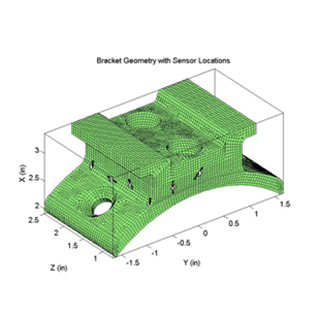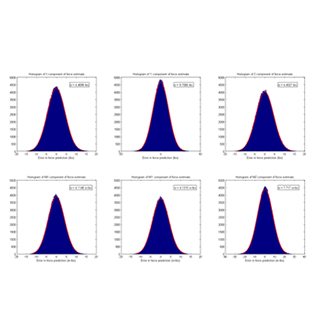Strain-based Trained Network Approach for Estimating 6DOF Reaction Forces
Sponsors / Collaborators: NAVAIR, ATA Engineering
The problem of accurately measuring load transfer between structural components is one that is of great interest for many applications. For this project, the objective is to design a system that will measure, in flight, the reaction forces going through an aircraft weapon store connector in 6 degrees of freedom (DOF). So as to avoid having to flight-qualify the system, neither the connector nor the load path may be altered. Furthermore, the system must be able to produce time histories of the dynamic loading occurring in the flight environment as well as accommodate an unknown degree of nonlinearity.
Our proposed solution involves developing a trained network of strain sensors affixed to the surface of the connector. A series of known loads can be applied to the bracket, and the measured strains can then be used to develop a calibration matrix relating strain to applied force. Subsequent strain measurements obtained can thus be used to predict the connector force.
Our research first focused on determining the optimal locations to place sensors. Due to the geometry of the part and other engineering constraints, there is a limited amount of space available where strain gages may be affixed. Furthermore, it is necessary to ensure that six independent components of strain are measured in order to be able to reconstruct all six components of applied force without ambiguity. As a result, we developed a method of calculating the fitness of a particular sensor arrangement called the weighted residual method. This approach is based on maximizing the trace of the Fisher information matrix, weighted according to which load components are most critical. Next, we developed a hybrid algorithm to select gage locations according to this metric using the results of a finite element model simulation of the connection. First, a genetic algorithm is run to select the first six sensors (the minimum for predicting forces in six DOF), and then a greedy algorithm is utilized to choose the remaining sensors. An example sensor layout is given in Figure 1, with a picture of the full missile launcher given in Figure 2.
Another focus of our research related to this project has been uncertainty quantification of the force prediction. We have formulated a model of the noise process and considered several sources of uncertainty, including sensor noise, load transfer through the mounting (e.g., the epoxy layer), uncompensated thermal drift, and high strain gradients, all of which can provide sources of uncertainty, particularly on small components. Some initial force component histograms subject to some forms of these uncertainties is shown in Figure 3, after Monte Carlo simulation. The generation of such probability density information permits probabilistic confidences to be assigned to sensor outputs.



